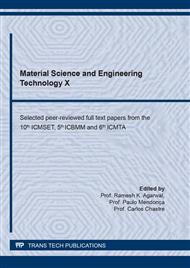p.104
p.109
p.119
p.125
p.131
p.137
p.143
p.148
p.157
Enhance Growth Temperature ZnO Nr Photoanode DSSC for Performance of Photo-Supercapacitor via Hydrothermal
Abstract:
Photo-supercapacitor (PSC) is integrated harvesting energy, that a combination of DSSC with a symmetric supercapacitor. A crucial part of the conversion of photon energy by DSSC is a photoanode. The DSSC photoanode used ZnO NR, because it is known as one of the optical semiconductor materials, which has bandgap of 3.37 eV. Due to good cycle stability and high conductivity, the supercapacitor electrode uses activated carbon-carbon black (AC-CB) materials. This study observed the enhance of temperature growth on the structure, morphology, and optical properties of ZnO NR photoanode to improve the photo-supercapacitor's performance. The hydrothermal method has been chosen to grow ZnO NR photoanode at growth temperature of 100, 150, and 200 °C for 4 hours. The structure, morphology, and optical properties of ZnO NR were analyzed by XRD, SEM-EDX, and UV Vis, respectively. The electrical performance of photo-supercapacitor were analyzed by IV data. XRD pattern has identified an increase peak in the hkl (002) of c-axis orientation and SEM data has identified that ZnO NR grows perpendicular to the substrate according to the preferred orientation. The optical properties has identified a shift to a small bandgap (redshift). For the electrical performance, photo-supercapacitor has increased in maximum current (Imax) as the growth temperature increases, and the maximum current is obtained by a growth temperature of 200 °C, which is 14.45 μA.
Info:
Periodical:
Pages:
131-136
Citation:
Online since:
February 2022
Authors:
Price:
Сopyright:
© 2022 Trans Tech Publications Ltd. All Rights Reserved
Share:
Citation:


